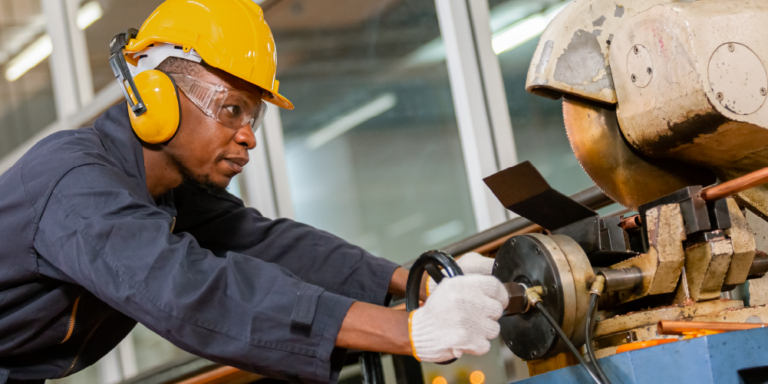Health and Safety Essex: Managing Construction Noise
Health and Safety Essex highlights that noise hazards are a frequent yet often overlooked risk on construction sites. The constant operation of heavy machinery, power tools, and ongoing activities generate high noise levels that can severely affect workers’ hearing and overall health. Extended exposure to loud noise doesn’t just cause discomfort—it can result in permanent hearing damage, stress-related health issues, and decreased productivity.
In this article, we will discuss effective strategies to manage noise hazards on construction sites, creating a safer environment for all workers.
Understanding Noise Hazards with Health and Safety Essex
Construction noise is typically measured in decibels (dB). According to the Control of Noise at Work Regulations 2005, employers must take action to reduce noise exposure at 80 dB(A) and provide hearing protection at 85 dB(A). However, many construction activities regularly exceed these limits. For example:
- Jackhammers: 100–120 dB
- Chainsaws: 110–120 dB
- Concrete saws: 90–110 dB
- Circular saws: 90–100 dB
When workers are exposed to such noise levels for extended periods, the risk of hearing damage increases significantly.
Legal Responsibilities
Employers in the UK are legally obligated to assess and control noise risks under the Control of Noise at Work Regulations. These laws require employers to:
- Assess Noise Levels: Determine the noise exposure levels on-site and identify workers who are at risk.
- Implement Control Measures: Take steps to reduce noise exposure where possible.
- Provide PPE: Supply appropriate hearing protection if risks remain after controls.
- Train Employees: Educate workers on the risks of noise exposure and how to use protective equipment correctly.
- Monitor and Review: Regularly review noise assessments and controls, especially when work processes change.
Risk Assessment and Planning
Managing noise hazards starts with a thorough noise risk assessment. This involves:
- Measuring Noise: Use a calibrated sound level meter or dosimeter to record noise levels across the site.
- Identifying Sources: List equipment and activities contributing to high noise levels.
- Evaluating Exposure: Determine how long workers are exposed and assess if it exceeds the daily or weekly exposure limit.
- Developing an Action Plan: Based on the findings, create a plan to eliminate or reduce the noise.
Incorporating noise control into the early stages of project planning can help avoid costly changes and interruptions later.
Engineering Controls
One of the most effective ways to manage noise is through engineering controls. These aim to reduce the noise at its source or block its path. Examples include:
- Quieter Equipment: Use machinery with low-noise features or electric alternatives.
- Barriers and Enclosures: Install acoustic barriers around noisy machinery or enclose high-noise areas.
- Regular Maintenance: Ensure machinery is well-maintained to avoid excess noise due to worn parts or loose components.
- Anti-Vibration Mounts: Use mounts or pads that reduce vibration noise on fixed equipment.
Investing in quieter tools and equipment may have a higher initial cost, but it can reduce long-term health risks and improve workplace efficiency.
Administrative Controls
Where engineering solutions are not enough, administrative controls can help limit workers’ exposure. These include:
- Rotating Workers: Alternate employees to reduce time spent in noisy areas.
- Scheduling: Plan noisy tasks during times when fewer workers are present.
- Quiet Zones: Establish designated quiet areas where workers can rest and recover.
- Warning Signs: Post clear signs in high-noise zones indicating that hearing protection is required.
Administrative measures are often easier and quicker to implement but should complement—not replace—engineering solutions.
Personal Protective Equipment (PPE)
When other control methods do not reduce noise to safe levels, hearing protection becomes essential. PPE options include:
- Earplugs: Lightweight and easy to use, suitable for moderate noise levels.
- Earmuffs: Offer higher protection and can be used in combination with earplugs for extreme environments.
- Custom Moulded Plugs: Provide a comfortable fit and consistent protection for frequent users.
Make sure PPE is compliant with safety standards (such as EN 352 in the UK), and train workers on how to fit and maintain their hearing protection properly.
Training and Awareness
No noise control programme is complete without proper training. Workers must understand:
- The risks associated with noise exposure.
- How to use hearing protection correctly.
- The importance of reporting faults or excessive noise.
Regular toolbox talks, signage, and visual reminders can reinforce the importance of hearing safety on-site.
Monitoring and Continuous Improvement
Noise management isn’t a one-time task. Continuous monitoring is crucial to ensure that the measures remain effective. Conduct regular site inspections, update noise assessments as projects evolve, and involve workers in providing feedback.
Implementing a “report and respond” system allows staff to flag emerging noise risks early, encouraging a proactive health and safety culture.
Final Thoughts
Managing noise hazards on construction sites is not just about meeting legal requirements—it’s about protecting workers’ long-term health and creating a more productive environment. Through a combination of risk assessments, engineering and administrative controls, PPE, and staff training, construction managers can effectively reduce the harmful impact of noise.
Whether you’re a contractor, site manager, or safety officer, following these practices ensures compliance and shows a commitment to workforce wellbeing. For expert advice and local support, consulting a Health and Safety in Essex professional can help ensure your site meets the highest safety standards. Investing in proper noise management through Health and Safety Essex guidance promotes not only compliance but also a culture of care and responsibility on every job site.
